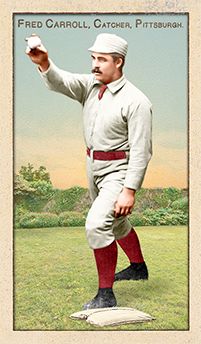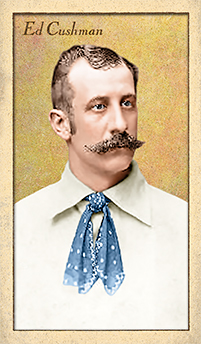- Series: Diamond Heads '15
- City: Detroit
- Team: Tigers
- League: American League
- Hall: National Baseball Hall of Fame
Samuel Earl Crawford (1880-1968) needed a couple more weeks among his 19 ML seasons to reach 3000 hits, finishing with 2961 and the all-time record for triples. “Wahoo Sam” teamed with Ty Cobb for 3 straight Series appearances ‘07-09. Neither did well or won a title. Nevertheless, the renowned manager who made Babe Ruth an outfielder said there was never a better hitter than Crawford. This Nebraska farm kid was considered the strongest hitter of his day and consistently ranked in the top 10 in slugging.
- Playing in the big Deadball Era parks, speedy Crawford set the record for inside-the-park HRs
- Debuting with Cincinnati in 1899, Crawford hit .307 as the youngest player in the majors
- A model of moderation, he rarely struck out, walked or reacted to teammate Cobb’s tirades
- Elected to Hall of Fame: 1957

- Series: Beginnings: 1880's
- City: Pittsburgh
- Team: Alleghenys
- League: National League
Frederick Herbert Carroll (1864-1904) was born in Sacramento and, per Bill James, never really adjusted to life in the East. James touts Carroll as perhaps the finest “young” catcher, not only of his era, but until the arrival of Johnny Bench. Fred was nineteen when he started for the Columbus Buckeyes of the American Association. He moved on to spend seven more years in MLB for three Pittsburgh franchises in the AA, NL and Players' League. During this fairly brief tenure, Carroll twice hit over .300 and twice was among the league leaders in home runs. His career average of .284 justifies James' assessment of the rare hitter with power at catcher. Hall of Famer Buck Ewing set the standard for 19th century catchers, but Carroll was as solid as they come. Carroll had quite a year in 1886 with the Alleghenys. He set career marks in hits, doubles, triples and runs. And he also faced a club suspension for fighting teammate Otto Schomberg. Team owners, perhaps realizing how disliked Schomberg was, quickly ended Carroll's exile and lowered his fine to $50. The following season Fred became the first Pittsburgh player to hit for the cycle.
- In 1889 Carroll led the league in on-base percentage and slugging, said by the Encyclopedia of Baseball Catchers to be a record production for a catcher of that age (24)
- Carroll left the Steel City for his home state, playing for Oakland and SF in the minors
- Carroll's uniform color on this card was changed in February, 2017 from blue to red to reflect recent reliable research by Craig Brown & friends at Threads of Our Game. One card had been previously released featuring a blue uniform.

- Series: 1880s: Diamond Duos
- City: Louisville
- Team: Colonels
- League: American Association
Paul Cook:
Paul Cook (1863-1905) got into three games at catcher for Harry Wright’s struggling Philadelphia Quakers at the end of the 1884 season. He returned to the minors before getting picked up by the Louisville Colonels where he stayed four years before jumping to Ward’s Wonders for the Players’ League season of 1890. Cook finished up the following year with three teams, back in Kentucky, then the Lincoln Rustlers and, finally, the St. Louis Browns. During his five years with the Colonels, Cook batted a mere .219 with no power.
- In his early days, Cook played for Muskegon in the Northwestern League, the Toledo Avengers of the Western League, and the Washington Nationals of the Eastern League
- Paul played in D.C. for manager Mike Scanlon who would lead the club in ‘86 as they joined the National League
Joe Werrick:
Joseph Abraham Werrick (1861-1943) broke into minor-league ball in 1884 with the Winona Clippers of the Northwestern League, moving to their St Paul franchise later that summer. Joe became a major-leaguer almost by accident as the Apostles of the Twin Cities became a late entry into the Union Association that September as the White Caps. Hitting less than a buck in nine games sent Werrick to the Nashville Americans of the Southern League in ‘85. The Louisville Colonels took him on in ‘86 and Joe rewarded them the following year with a terrific output: .285 BA, 99 RBI and 49 steals. Unfortunately, his average plummeted to .215 in ‘88 and Werrick sought the shelter of the minors for the remainder of his lengthy tenure. He played for various teams in the Virginia and Interstate Leagues, finishing up with the Mansfield Haymakers in 1899 showing he still had power with 11 HRs and a .297 average.
- In his short-lived debut, Joe participated in a unique “record.” St Paul was a last-minute fill-in for the moribund Union Assoc and played only nine road games--a “major league” team that never played a home game
Auction History
Cartophilia
Old Judge Pose: 92-1

- Series: Beginnings: 1880's
- City: Louisville
- Team: Colonels
- League: American Association
Paul Cook (1863-1905) got into three games at catcher for Harry Wright’s struggling Philadelphia Quakers at the end of the 1884 season. He returned to the minors before getting picked up by the Louisville Colonels where he stayed four years before jumping to Ward’s Wonders for the Players’ League season of 1890. Cook finished up the following year with three teams, back in Kentucky, then the Lincoln Rustlers and, finally, the St. Louis Browns. During his five years with the Colonels, Cook batted a mere .219 with no power.
- In his early days, Cook played for Muskegon in the Northwestern League, the Toledo Avengers of the Western League, and the Washington Nationals of the Eastern League
- Paul played in D.C. for manager Mike Scanlon who would lead the club in ‘86 as they joined the National League
- Cook's uniform color on this card was changed in January, 2017 from blue to maroon to reflect recent reliable research by Craig Brown & friends at Threads of Our Game. One card had been previously released featuring a blue uniform.

- Series: 1880s: Spotted Ties
- City: New York
- Team: Metropolitans
- League: American Association
Edgar Leander Cushman (1852-1915) was a left-handed pitcher with a less-than-stellar career record of 62-80 despite a sub-4.00 ERA. He was at times brilliant, as witnessed by his performance in his second year in the majors. Cushman had gotten into a handful of games for the Buffalo Bisons in 1883 and returned to the “big leagues” at the end of the '84 season with the Union Association's Milwaukee Brewers, themselves a late-season replacement in the by then moribund league. Ed was dazzling. In the team's second UA game, he hurled the league's second (and final) no-hitter on September 28 against the Washington Nationals. In his next start Cushman nearly duplicated his feat, only surrendering a sole hit in the ninth inning of another shut-out against the Boston Reds. He caught the attention of American Association owners and was signed by the Philadelphia Athletics for '85. Ten starts later Cushman found himself moved north to the New York Metropolitans. Late in that campaign Ed struck out eight straight Alleghenys. The Mets named Cushman Pitcher of the Year for both the 1885 and '86 seasons. After returning to the minors in 1888, Ed got one last shot in the majors when Charlie Morton gained entry into the AA for his Toledo Maumees for their only major league season, 1890. Ed had moved out to Morton's Des Moines team in the Western Association and Morton kept him when he took over the Toledo franchise.
- Cushman's strongest year was 1886 for New York. He hurled 325 innings, going 17-21 with a fine 3.12 ERA
Auction History
Cartophilia
Old Judge Pose: 107-1




